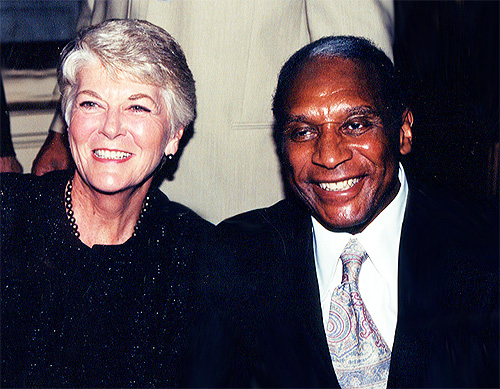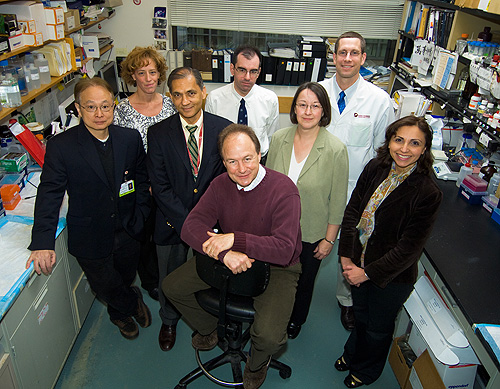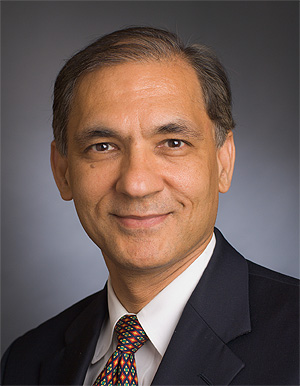Not long ago, a diagnosis of multiple myeloma — a cancer of the bone marrow — carried with it a very poor prognosis, with median survival estimates of just two to three years. Now, thanks in large part to research and treatment advances at Dana-Farber/Brigham and Women’s Cancer Center (DF/BWCC), this disease is for many patients a chronic, and more manageable disease, with prognosis now improved to median survivals of seven to ten years.
Here is a look at how DF/BWCC physician-scientists and patients have helped lead the way toward improved treatment for multiple myeloma over the past three decades.

For the past two decades, much of that work has taken place at the Jerome Lipper Multiple Myeloma Center and LeBow Institute for Myeloma Therapeutics, seen here being dedicated with program director Kenneth Anderson, MD (right). Anderson, who is also the Kraft Family Professor of Medicine at Harvard Medical School, and his laboratory and research teams have made some of the biggest breakthroughs in multiple myeloma research history.

Participation by patients in clinical trials, so important to the understanding of any disease, is a major focus of the Lipper Center, which under the Clinical Research and Program leadership of Paul Richardson, MD, RJ Corman Professor of Medicine at Harvard Medical School, has conducted more than 110 studies in the group over the last decade. Two DF/BWCC multiple myeloma patients who were staunch advocates for clinical trials starting in the 1990s were the late New England Patriots football player Ron Burton and Congresswoman and U.S. vice presidential candidate Geraldine Ferraro.

More recently, Richardson (seated at center) and his clinical team devised a three-drug treatment for multiple myeloma (so-called RVD) that has shown unprecedented patient response rates in numerous clinical trials. This highly effective regimen was informed by seminal work from the Anderson laboratory, and has resulted in the combination and several like it becoming a new standard in the United States for the treatment of multiple myeloma in both newly diagnosed and relapsed settings.

Today, genomic research by Lipper Center Director for Basic and Correlative Science and Professor of Medicine at Harvard Medical School Nikhil Munshi, MD, and others is identifying novel targets and antigens associated with multiple myeloma, and developing molecular therapeutic strategies including immunotherapy. This research is changing our understanding of the disease and paving the way for the development of personalized medicine with eventual cure in the near future.

Thanks. Keep fighting!
Fascinating info. When I was diagnosed in 1995 I had no idea of the statistics then on life expectancy. I am glad these advancements have occurred since my MM had become active after 20+ years.
Your team gave my husband 3 1/2 years and I so appreciate that (we both did). I hope that all of what turned out to be ”aggressive MM” blood which he donated at the time of diagnosis has helped in the work you are doing to give to others a quality of life extended for more years than 3 1/2. It sounds like that is the case. All the faces in your team photo are the faces of our greatest supporters and friends. Thank-you.
My Husband was diagnosed in July 2006. The first treatment they ended up stopping because of multiple reactions. He has been on Thalidamide. Decadron, Hefty dose of Dexametazone, which had to be split and done every other week instead of all at once , once a month because he couldn’t tolerate it. Once again he’s finding it hard to tolerate.His IGA was up to 1210 in January. We expect he will need to go back on chemotherapy soon. the Dr. says when he nears 1500 he will start him back up.He started out over 6000, they got him down to 250+-. The only problem is they are not sure what they can treat him with at this point.I must tell you he has multiple other disorders. Severe asthma, Churg-Strauss, prostate cancer that he went through radiation for. That seems to be in remission at this point. PSI 0.4 irregular heart rhythm, some heart muscle myopathy. He has a bone lesion on the back of the head, and I think one other spot.Is there any new treatments that insurance will pay for. His quality of life at this time is poor at best. He spends the majority of time in bed, in pain. He also has high blood pressure. I’m sure I’m forgetting something. Sleep apnea, 80% +- sponylolithesis in the LS region. arthritis. He is 60 years old.They found something strange in his blood years ago, but never really pursued it. Any suggestions would help. We may be pursuing a second opinion at your Massachusetts facility.
Hi Penny:I’m real sorry to hear of your husband’s health battles. We can’t give out any specific medical advice via this blog, but a second opinion — whether you do it here or elsewhere — is often good to have. The link to our Multiple Myeloma web site is here: http://www.dana-farber.org/Adult-Care/Treatment-and-Support/Treatment-Centers-and-Clinical-Services/Hematologic-Oncology-Treatment-Center/Multiple-Myeloma-Program.aspxThe phone number is: 617-632-3823 or 617-632-5138 I hope that’s helpful.–Michael Buller
Sorry your husband is facing multiple challenges. You are both in our prayers.I was diagnosed with mm and given at most 3 years to live, that was 22 years ago.At one point I was advised to enter a hospice. But, we refused to give up and entered a clinical trial at Dana Farber. Dr Paul Richardson and his team turned our world around. The trial drug is now Velcade. That was 12 years ago. In 2012 I developed treatment related leukemia and had my 4th stem cell transplant. I am now in remission for both cancers and lead an active life at age 65. Second opinions, clinical trials, daily exercise and my wife, Kathleen’s terrific support and care are why I am alive. Be strong. Contact me if you like at Jim.bond48@gmail.com
Hi Jim thank you so much for your imput , My name is Mary Moore and I was diagnosed February 2015 I did the same treatment and doing well.my problem right now is i should do the bone marrow transplant or stay on meds I really don’t know what to do I am praying that the Lord will guide me in the right decision. I am glad you are doing great despite all challenges my God keep blessing. You will be in my prayers.
I realize this is an old article but I have to comment. This is such an encouraging article to read. I’m grateful of the doctors but there is one group that was not mentioned in the article I would like to thank, and that is the donors. Whether it be monetary or those who donated their remaining time with their loved ones to contribute to clinical trials. We lost my Grandfather to Multiple Myeloma in 2002. Shortly after his death we started an annual fundraising golf tournament to provide funds for research and development of a cure for this deadly disease. We raised over $50,000 in the five years we hosted the golf tournament. In addition, I know that there are similar families raising funds and those that offer their time to contribute to the clinical trials. Please don’t forget to thank those that have supported the research as well as those behind the microscopes. Everyone that participates in this battle, regardless of their job, needs to thanked! Too many people live their remaining days, weeks, months, and if you’re lucky years, suffering from this deadly disease. So thank you to all that are involved with Multiple Myeloma every dollar, hour worked, and clinical trial can be one step closer to a long term solution for this disease.